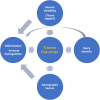MPPED2 Polymorphism Is Associated With Altered Systemic Inflammation and Adverse Trauma Outcomes
- PMID: 31781170
- PMCID: PMC6857553
- DOI: 10.3389/fgene.2019.01115
MPPED2 Polymorphism Is Associated With Altered Systemic Inflammation and Adverse Trauma Outcomes
Abstract
Trauma is a leading cause of morbidity and mortality. It is unclear why some trauma victims follow a complicated clinical course and die, while others, with apparently similar injury characteristics, do not. Interpatient genomic differences, in the form of single nucleotide polymorphisms (SNPs), have been associated previously with adverse outcomes after trauma. Recently, we identified seven novel SNPs associated with mortality following trauma. The aim of the present study was to determine if one or more of these SNPs was also associated with worse clinical outcomes and altered inflammatory trajectories in trauma survivors. Accordingly, of 413 trauma survivors, DNA samples, full blood samples, and clinical data were collected at multiple time points in the first 24 h and then daily over 7 days following hospital admission. Subsequently, single-SNP groups were created and outcomes, such as hospital length of stay (LOS), ICU LOS, and requirement for mechanical ventilation, were compared. Across a broad range of Injury Severity Scores (ISS), patients carrying the rs2065418 TT SNP in the metallophosphoesterase domain-containing 2 (MPPED2) gene exhibited higher Marshall MODScores vs. the control group of rs2065418 TG/GG patients. In patients with high-severity trauma (ISS ≥ 25, n = 94), those carrying the rs2065418 TT SNP in MPPED2 exhibited higher Marshall MODScores, longer hospital LOS (21.8 ± 2 days), a greater requirement for mechanical ventilation (9.2 ± 1.4 days on ventilator, DOV), and higher creatinine plasma levels over 7 days vs. the control group of rs2065418 TG/GG high-severity trauma patients (LOS: 15.9 ± 1.2 days, p = 0.03; DOV: 5.7 ± 1 days, p = 0.04; plasma creatinine; p < 0.0001 MODScore: p = 0.0003). Furthermore, rs2065418 TT patients with ISS ≥ 25 had significantly different plasma levels of nine circulating inflammatory mediators and elevated dynamic network complexity. These studies suggest that the rs2065418 TT genotype in the MPPED2 gene is associated with altered systemic inflammation, increased organ dysfunction, and greater hospital resource utilization. A screening for this specific SNP at admission might stratify severely injured patients regarding their lung and kidney function and clinical complications.
Keywords: SNP; genomics; inflammation; outcomes; systems biology; trauma; ventilation.
Copyright © 2019 Schimunek, Namas, Yin, Barclay, Liu, el-Dehaibi, Abboud, Cohen, Zamora, Billiar and Vodovotz.
Figures




Similar articles
-
An Enrichment Strategy Yields Seven Novel Single Nucleotide Polymorphisms Associated With Mortality and Altered Th17 Responses Following Blunt Trauma.Shock. 2018 Mar;49(3):259-268. doi: 10.1097/SHK.0000000000000987. Shock. 2018. PMID: 28930911 Free PMC article. Clinical Trial.
-
Impact of Injury Severity on Dynamic Inflammation Networks Following Blunt Trauma.Shock. 2015 Aug;44(2):101-9. doi: 10.1097/SHK.0000000000000395. Shock. 2015. PMID: 26009819 Free PMC article.
-
An Aging-Related Single-Nucleotide Polymorphism is Associated With Altered Clinical Outcomes and Distinct Inflammatory Profiles in Aged Blunt Trauma Patients.Shock. 2020 Feb;53(2):146-155. doi: 10.1097/SHK.0000000000001411. Shock. 2020. PMID: 31318836 Free PMC article.
-
Early tracheostomy in intensive care trauma patients improves resource utilization: a cohort study and literature review.Crit Care. 2004 Oct;8(5):R347-52. doi: 10.1186/cc2924. Epub 2004 Aug 23. Crit Care. 2004. PMID: 15469579 Free PMC article. Review.
-
Effectiveness of dexmedetomidine versus propofol on extubation times, length of stay and mortality rates in adult cardiac surgery patients: a systematic review and meta-analysis.JBI Database System Rev Implement Rep. 2018 May;16(5):1220-1239. doi: 10.11124/JBISRIR-2017-003488. JBI Database System Rev Implement Rep. 2018. PMID: 29762314
Cited by
-
Epigenetics Is Implicated in the Basis of Gender Incongruence: An Epigenome-Wide Association Analysis.Front Neurosci. 2021 Aug 19;15:701017. doi: 10.3389/fnins.2021.701017. eCollection 2021. Front Neurosci. 2021. PMID: 34489625 Free PMC article.
-
Neuronal expression in Drosophila of an evolutionarily conserved metallophosphodiesterase reveals pleiotropic roles in longevity and odorant response.PLoS Genet. 2023 Sep 21;19(9):e1010962. doi: 10.1371/journal.pgen.1010962. eCollection 2023 Sep. PLoS Genet. 2023. PMID: 37733787 Free PMC article.
-
Plasma proteomics reveals early, broad release of chemokine, cytokine, TNF, and interferon mediators following trauma with delayed increases in a subset of chemokines and cytokines in patients that remain critically ill.Front Immunol. 2022 Nov 30;13:1038086. doi: 10.3389/fimmu.2022.1038086. eCollection 2022. Front Immunol. 2022. PMID: 36532045 Free PMC article.
-
Integrative GWAS and co-localisation analysis suggests novel genes associated with age-related multimorbidity.Sci Data. 2023 Sep 25;10(1):655. doi: 10.1038/s41597-023-02513-4. Sci Data. 2023. PMID: 37749083 Free PMC article.
-
A common single nucleotide polymorphism is associated with inflammation and critical illness outcomes.iScience. 2023 Oct 28;26(12):108333. doi: 10.1016/j.isci.2023.108333. eCollection 2023 Dec 15. iScience. 2023. PMID: 38034362 Free PMC article.
References
-
- Abdul-Malak O., Vodovotz Y., Zaaqoq A., Guardado J., Almahmoud K., Yin J., et al. (2016). Elevated admission base deficit is associated with a complex dynamic network of systemic inflammation which drives clinical trajectories in blunt trauma patients. Mediators Inflammation 2016, 7950374. 10.1155/2016/7950374 - DOI - PMC - PubMed
-
- Baker S. P., O’Neill B., Haddon W. Jr., and Long W. B. (1974). The injury severity score: a method for describing patients with multiple injuries and evaluating emergency care. J. Trauma 14 (3), 187–196. - PubMed
Grants and funding
LinkOut - more resources
Full Text Sources
Miscellaneous

